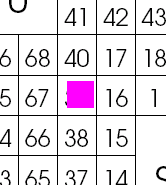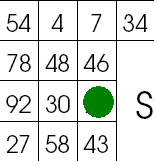By Michael Hartley
Here's a math board game with a lot of nice features. On another page, you can find a list of all the math board games on this site.
- This game is easy to prepare, just download, print, and cut out the pieces.
- The rules are simple. See below!
- It will help kids grasp important arithmetic skills, including times tables and mental addition
- Best of all, it's totally free!
Let me explain how it works. If you download the math board game set, you'll see about 6 pages of printable stuff - the game boards, cards and playing pieces for the game. Let me explain what they all are.
- The first four pages are various game boards. You only need one game board to play, but for some variation, I've provided four game boards, with different arrangements of the numbers on each one. I recommend you print the board of your choice on larger paper - or print on normal paper, then enlarge it using a photocopy machine.
- The next page contains some cards to be used in the game. There are two types of card, number cards and operation cards. Photocopy a large number of each, preferably onto cardboard, then cut them out.
- The last page contains some playing pieces of various shapes and colors. Of course, you won't need these if you have something else you can use - counters, coins, buttons or beads for example. I've provided some large counters and some small counters - the small ones are in case you are not able to make a large copy of the game board. Each player will need two playing pieces.
The rules of the game are as follows.
- Start by shuffling the number cards and the operation cards, and putting them in two paper bags.
- Each player starts with two playing pieces, and puts them in the large square in the centre of the game board (the one marked Start).
- Each player draws a number card. The player with the highest number goes first.
- A player takes his or her turn like so :
- The player draws three number cards and two operation cards.
- The player then has one minute to form an arithmetic formula using the cards drawn.
- He or she does not have to use all the cards.
- He or she can insert brackets anywhere in the formula.
- The result of the formula should equal a number next to one of his or her counters.
- The player then moves his or her counter onto the new square.
- If the player forms the formula incorrectly, the playing piece he or she tried to move will return to the Start.
- At the end of the turn, all the cards are returned back to their respective paper bags.
- At most one piece may be moved on each turn. If the player decides not to move, he or she should call pass and return the cards to the bags.
- Pieces may only be moved vertically or horizontally (not diagonally), and cannot be moved into squares that are already occupied.
- The winner is the first player to reach a square numbered 0 (zero).
Let me give an example to help clarify how a player takes his or her turn.
Suppose we were playing on game board A, and I had my piece on the square numbered 39.

Then, suppose I drew the operation cards
 and
and  , and the number
cards 4, 9 and 4. In this case, I would have two squares available to move to.
, and the number
cards 4, 9 and 4. In this case, I would have two squares available to move to.
- I could form the sum 4
 4, and move to the
square labeled 16, or
4, and move to the
square labeled 16, or
- I could form the sum 4
 9
9 4, and move to the
square labeled 40. That's right, the
4, and move to the
square labeled 40. That's right, the  card means either plus or minus.
card means either plus or minus.
- On the other hand, if I tried to say 9
 (4
(4 4) equals 67, and
you picked up the error, you could force me to return my counter to the Start square.
4) equals 67, and
you picked up the error, you could force me to return my counter to the Start square.
Here are some suggestions to make the game easier or harder. Use your discretion to determine the best set of rules for the age group you are dealing with.
- Up to a point, the game will be easier if each player is allowed to draw more cards. You could even give an advantage to weaker players by allowing them to draw more, and allowing the stronger players to draw fewer. On the other hand, too many cards may overwhelm a player's capacity for mental arithmetic.
- Allowing calculators might make the game easier. However, it will mean different skills are being learned.
- Another way to make the game easier is to allow more than one move with the same set of cards. For example, suppose you are on square 77 of
game board D, and you draw number cards 5, 6 and 8, and operation cards
 and
and  .
.

- You could first form 5
 6 and move to square 30.
6 and move to square 30.
- Then, on the same turn, you could rearrange the cards to
form 6
 8, and move to square 48.
8, and move to square 48.
- Finally, you could (if you wanted to) rearrange them a third time to form (5
 8)
8) 6 and move to square 78!
6 and move to square 78!
- You could first form 5
- To make the game harder, if a player passes, give other players a chance to form a sum with his or her cards, and force him or her to move even if he or she doesn't want to.
- Another way to make the game harder is to allow each player just one playing piece instead of two. Conversely, allowing three playing pieces will make the game easier.
And by the way, thanks for using this game!
Yours, Dr Mike...
